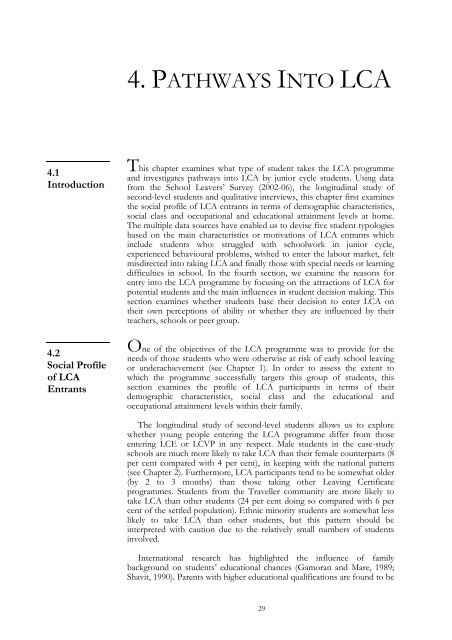Student Experiences of the Leaving Certificate Applied Programme
Student Experiences of the Leaving Certificate Applied Programme
Student Experiences of the Leaving Certificate Applied Programme
You also want an ePaper? Increase the reach of your titles
YUMPU automatically turns print PDFs into web optimized ePapers that Google loves.
4. PATHWAYS INTO LCA4.1IntroductionThis chapter examines what type <strong>of</strong> student takes <strong>the</strong> LCA programmeand investigates pathways into LCA by junior cycle students. Using datafrom <strong>the</strong> School Leavers’ Survey (2002-06), <strong>the</strong> longitudinal study <strong>of</strong>second-level students and qualitative interviews, this chapter first examines<strong>the</strong> social pr<strong>of</strong>ile <strong>of</strong> LCA entrants in terms <strong>of</strong> demographic characteristics,social class and occupational and educational attainment levels at home.The multiple data sources have enabled us to devise five student typologiesbased on <strong>the</strong> main characteristics or motivations <strong>of</strong> LCA entrants whichinclude students who: struggled with schoolwork in junior cycle,experienced behavioural problems, wished to enter <strong>the</strong> labour market, feltmisdirected into taking LCA and finally those with special needs or learningdifficulties in school. In <strong>the</strong> fourth section, we examine <strong>the</strong> reasons forentry into <strong>the</strong> LCA programme by focusing on <strong>the</strong> attractions <strong>of</strong> LCA forpotential students and <strong>the</strong> main influences in student decision making. Thissection examines whe<strong>the</strong>r students base <strong>the</strong>ir decision to enter LCA on<strong>the</strong>ir own perceptions <strong>of</strong> ability or whe<strong>the</strong>r <strong>the</strong>y are influenced by <strong>the</strong>irteachers, schools or peer group.4.2Social Pr<strong>of</strong>ile<strong>of</strong> LCAEntrantsOne <strong>of</strong> <strong>the</strong> objectives <strong>of</strong> <strong>the</strong> LCA programme was to provide for <strong>the</strong>needs <strong>of</strong> those students who were o<strong>the</strong>rwise at risk <strong>of</strong> early school leavingor underachievement (see Chapter 1). In order to assess <strong>the</strong> extent towhich <strong>the</strong> programme successfully targets this group <strong>of</strong> students, thissection examines <strong>the</strong> pr<strong>of</strong>ile <strong>of</strong> LCA participants in terms <strong>of</strong> <strong>the</strong>irdemographic characteristics, social class and <strong>the</strong> educational andoccupational attainment levels within <strong>the</strong>ir family.The longitudinal study <strong>of</strong> second-level students allows us to explorewhe<strong>the</strong>r young people entering <strong>the</strong> LCA programme differ from thoseentering LCE or LCVP in any respect. Male students in <strong>the</strong> case-studyschools are much more likely to take LCA than <strong>the</strong>ir female counterparts (8per cent compared with 4 per cent), in keeping with <strong>the</strong> national pattern(see Chapter 2). Fur<strong>the</strong>rmore, LCA participants tend to be somewhat older(by 2 to 3 months) than those taking o<strong>the</strong>r <strong>Leaving</strong> <strong>Certificate</strong>programmes. <strong>Student</strong>s from <strong>the</strong> Traveller community are more likely totake LCA than o<strong>the</strong>r students (24 per cent doing so compared with 6 percent <strong>of</strong> <strong>the</strong> settled population). Ethnic minority students are somewhat lesslikely to take LCA than o<strong>the</strong>r students, but this pattern should beinterpreted with caution due to <strong>the</strong> relatively small numbers <strong>of</strong> studentsinvolved.International research has highlighted <strong>the</strong> influence <strong>of</strong> familybackground on students’ educational chances (Gamoran and Mare, 1989;Shavit, 1990). Parents with higher educational qualifications are found to be29

















